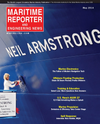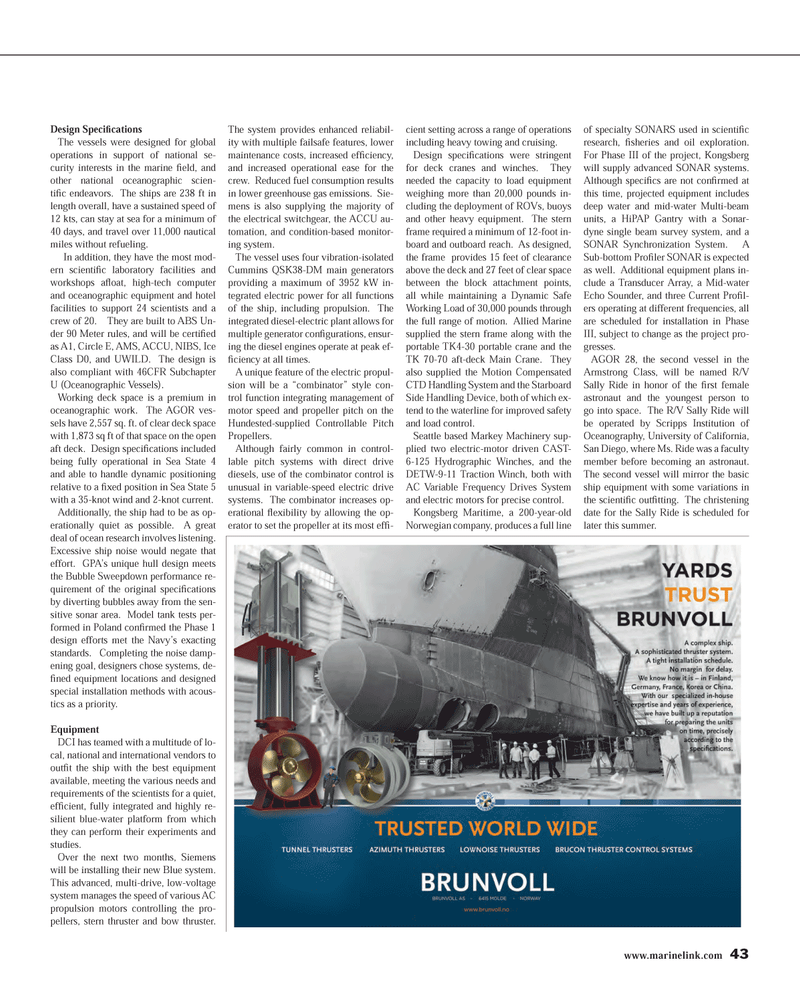
Page 43: of Maritime Reporter Magazine (May 2014)
Marine Electronics Edition
Read this page in Pdf, Flash or Html5 edition of May 2014 Maritime Reporter Magazine
www.marinelink.com 43
Design Specifi cations
The vessels were designed for global operations in support of national se- curity interests in the marine fi eld, and other national oceanographic scien- tifi c endeavors. The ships are 238 ft in length overall, have a sustained speed of 12 kts, can stay at sea for a minimum of 40 days, and travel over 11,000 nautical miles without refueling. In addition, they have the most mod- ern scientifi c laboratory facilities and workshops afl oat, high-tech computer and oceanographic equipment and hotel facilities to support 24 scientists and a crew of 20. They are built to ABS Un- der 90 Meter rules, and will be certifi ed as A1, Circle E, AMS, ACCU, NIBS, Ice
Class D0, and UWILD. The design is also compliant with 46CFR Subchapter
U (Oceanographic Vessels).
Working deck space is a premium in oceanographic work. The AGOR ves- sels have 2,557 sq. ft. of clear deck space with 1,873 sq ft of that space on the open aft deck. Design specifi cations included being fully operational in Sea State 4 and able to handle dynamic positioning relative to a fi xed position in Sea State 5 with a 35-knot wind and 2-knot current.
Additionally, the ship had to be as op- erationally quiet as possible. A great deal of ocean research involves listening.
Excessive ship noise would negate that effort. GPA’s unique hull design meets the Bubble Sweepdown performance re- quirement of the original specifi cations by diverting bubbles away from the sen- sitive sonar area. Model tank tests per- formed in Poland confi rmed the Phase 1 design efforts met the Navy’s exacting standards. Completing the noise damp- ening goal, designers chose systems, de- fi ned equipment locations and designed special installation methods with acous- tics as a priority.
Equipment
DCI has teamed with a multitude of lo- cal, national and international vendors to outfi t the ship with the best equipment available, meeting the various needs and requirements of the scientists for a quiet, effi cient, fully integrated and highly re- silient blue-water platform from which they can perform their experiments and studies.
Over the next two months, Siemens will be installing their new Blue system.
This advanced, multi-drive, low-voltage system manages the speed of various AC propulsion motors controlling the pro- pellers, stern thruster and bow thruster.
The system provides enhanced reliabil- ity with multiple failsafe features, lower maintenance costs, increased effi ciency, and increased operational ease for the crew. Reduced fuel consumption results in lower greenhouse gas emissions. Sie- mens is also supplying the majority of the electrical switchgear, the ACCU au- tomation, and condition-based monitor- ing system.
The vessel uses four vibration-isolated
Cummins QSK38-DM main generators providing a maximum of 3952 kW in- tegrated electric power for all functions of the ship, including propulsion. The integrated diesel-electric plant allows for multiple generator confi gurations, ensur- ing the diesel engines operate at peak ef- fi ciency at all times.
A unique feature of the electric propul- sion will be a “combinator” style con- trol function integrating management of motor speed and propeller pitch on the
Hundested-supplied Controllable Pitch
Propellers.
Although fairly common in control- lable pitch systems with direct drive diesels, use of the combinator control is unusual in variable-speed electric drive systems. The combinator increases op- erational fl exibility by allowing the op- erator to set the propeller at its most effi - cient setting across a range of operations including heavy towing and cruising.
Design specifi cations were stringent for deck cranes and winches. They needed the capacity to load equipment weighing more than 20,000 pounds in- cluding the deployment of ROVs, buoys and other heavy equipment. The stern frame required a minimum of 12-foot in- board and outboard reach. As designed, the frame provides 15 feet of clearance above the deck and 27 feet of clear space between the block attachment points, all while maintaining a Dynamic Safe
Working Load of 30,000 pounds through the full range of motion. Allied Marine supplied the stern frame along with the portable TK4-30 portable crane and the
TK 70-70 aft-deck Main Crane. They also supplied the Motion Compensated
CTD Handling System and the Starboard
Side Handling Device, both of which ex- tend to the waterline for improved safety and load control.
Seattle based Markey Machinery sup- plied two electric-motor driven CAST- 6-125 Hydrographic Winches, and the
DETW-9-11 Traction Winch, both with
AC Variable Frequency Drives System and electric motors for precise control.
Kongsberg Maritime, a 200-year-old
Norwegian company, produces a full line of specialty SONARS used in scientifi c research, fi sheries and oil exploration.
For Phase III of the project, Kongsberg will supply advanced SONAR systems.
Although specifi cs are not confi rmed at this time, projected equipment includes deep water and mid-water Multi-beam units, a HiPAP Gantry with a Sonar- dyne single beam survey system, and a
SONAR Synchronization System. A
Sub-bottom Profi ler SONAR is expected as well. Additional equipment plans in- clude a Transducer Array, a Mid-water
Echo Sounder, and three Current Profi l- ers operating at different frequencies, all are scheduled for installation in Phase
III, subject to change as the project pro- gresses.
AGOR 28, the second vessel in the
Armstrong Class, will be named R/V
Sally Ride in honor of the fi rst female astronaut and the youngest person to go into space. The R/V Sally Ride will be operated by Scripps Institution of
Oceanography, University of California,
San Diego, where Ms. Ride was a faculty member before becoming an astronaut.
The second vessel will mirror the basic ship equipment with some variations in the scientifi c outfi tting. The christening date for the Sally Ride is scheduled for later this summer.
MR #5 (42-49).indd 43 5/1/2014 9:58:31 AM

 42
42

 44
44
